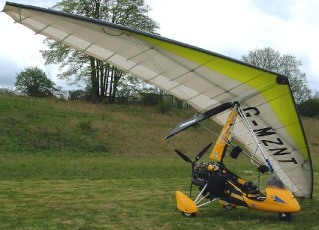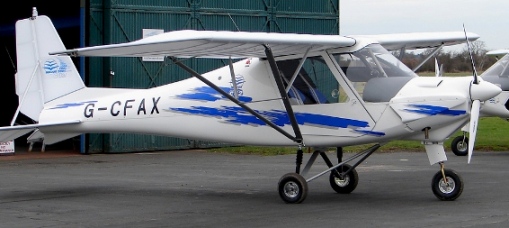Training & Experiences
Hunsdon Microlight Club, through its Chief Flying Instructor, is able to offer both full flying training, leading to the award of a pilot's licence and "air experience" trial lessons. These let you "try it to see if you like it" & also make great presents for birthdays & Christmas. To book training email training@hunsdonmicrolightclub.info. To purchase "air experience" trial lesson vouchers, please use the PayPal option below.
Please note that the legal minimum age for undertaking flying lessons (including trial "air experience" flights) is 14 years old. As long as you're fit, & less than about 95-100kg in weight (because the aircraft are limited by law to a maximum take off weight), there are no upper age limits.
Prices
(Much cheaper than GA Flying!)
| "Air Experience" Trial Lessons:- | £140 for a flying hour |
| Flexwing & 3 axis Training (School Aircraft):- | £140 per flying hour. Includes pre-& post-flight briefings |
| Student's Aircraft (Dual):- | £75 per flying hour. Includes pre-& post-flight briefings |
| Solo student supervision:- | £50 per flying hour (student's aircraft) |
| Ground school (for theory exams):- | £15 per ½ hour session |
| Theory Exams:- | £50 each. |
Training
Microlight pilots require a National Private Pilot’s Licence with a Microlight Class Rating (NPPL (M)) to fly unsupervised within the UK. It is issued by the CAA upon completion of a programme of training to the BMAA NPPL Microlight syllabus and the passing of a General Skills Test (GST).
Student pilots need to fly solo under supervision to gain experience before the GST, but before they can they must pass the Air Law Examination and hold a completed NPPL medical "self declaration of fitness". Student pilots cannot carry a passenger (instructors count as "crew", not passengers).
In order to carry passengers, a pilot needs to hold a valid licence and meet the medical requiremenats laid down by the CAA. Information regardiing medical requirements can be found here: CAA
Medical Requirements for Private Pilots, with the required "self declaration" here.The Licence is issued in two forms:
The Restricted Licence (a NPPL with a Microlight Class Rating With Operational Limitations) requires the student to complete a minimum of 15 hours flight instruction including 7 hours solo supervision although, in practice, this realistically takes between 25 and 35 hours tuition including 10 to 15 hours solo supervision. Multiple choice type examinations must be passed in Aviation Law, Navigation, Meteorology, Aeroplanes General, Human Performance & Limitations and a General Skill Test (GST) must be completed with a CAA Flight Examiner.
It should be noted that the Restricted Licence allows pilots to fly no further than 8 nautical miles from their take-off site with a cloudbase of not less than 1000 feet, a wind of less than 15 knots and a flight visibility of not less than 10 km. Furthermore, they can only carry passengers when they have at least 25 hours total experience including 10 hours solo, which has been signed off by an Examiner.
The Unrestricted Licence (a NPPL with a Microlight Class Rating Without Operational Limitations) requires, in addition to the above, a minimum of 5 hours navigational training including 2 solo cross country flights and their total flight tuition time to be 25 hours. The restrictions above then no longer apply. Nearly all pilots opt to go straight for the unrestricted licence.
(Adobe Acrobat needed to read - download here)
Microlight Types
Training at Hunsdon Microlight Club is available for both flexwing (using a Pegasus Quantum) & three axis (using a Ikarus C42) microlights. All microlights have to meet legal definitions. Of these the most obvious is a maximum take off weight (inc. crew & fuel) of 450Kg. You'll learn more about these rules as you progress through training!
Flexwing Microlights
Flexwings use Rogallo wings controlled by weight shift, These were originally designed by a NASA scientist when ways of returning early space vehicles to earth were being developed. NASA chose another option, but the design lived on. The first widespread use was in hang-gliders, which flexwing microlights developed from. However, as they carry heavier loads, modern flexwing microlight wings would be much too big & heavy for a glider pilot to pick up & run with! These aircraft have a fantastic "fun factor", allowing wonderful views & have been called "the motorbikes of the sky". They are also fairly easy to store, as the wing can be dismantled & stored in a long bag.

Pegasus Quantum - as used for training at Hunsdon
Three Axis Microlights
These aircraft are similar to heavier GA types like Cessnas. They use the "conventional" 3-axis control method of rudder, ailerons & elevators. The main advantages of operating a three axis microlight over a heavier GA type aircraft is that the licencing & medical requirements are less demanding, & you can maintain the aircraft yourself, rather than pay an (expensive) CAA certified engineer to do it for you. Three-axis aircraft are typically a bit faster than flexwings & you're "indoors", but the views out are not normally as good & storage can be more difficult.

Ikarus C42 - as used for training at Hunsdon
Chief Flying Instructor Biography
The Chief Flying Instructor at Hunsdon is Reg Barber. Reg is a very experienced pilot & engineer. Reg spent most of his life involved with kart and motor racing, having started working for Formula 1 driver Peter Arundell. He taught his son Westley to drive who then went on to become a well know racing driver and European Kart Champion. He also taught Princes William & Harry to drive karts. He worked alongside manufacturers developing their kart racing engines, one of which was Rotax, who also make the engines used on most microlights. He started flying in conventional aircraft in 1980 and microlights in 1999. After gaining over 200 hours in microlights he decided to see if he could instruct in microlights as well as he did on the track and, after completing his instructor course with Gerry Breen, one of the UK's most respected microlight instructor trainers, he joined Gerry's team. Since then he's worked at various airfields developing his training skills & knowledge. We are very fortunate in having Reg as our CFI at Hunsdon. Reg trains on both flexwing & three axis aircraft, concentrating on the latter.
Reg & X-Air 3 axis microlight (on floats!) (© Gerry Breen)